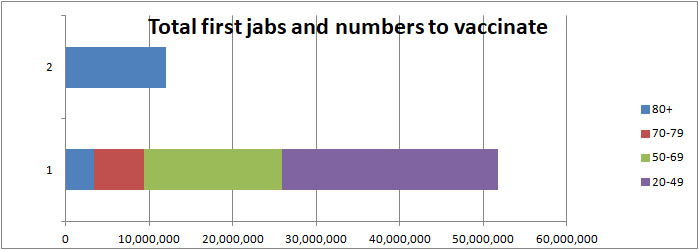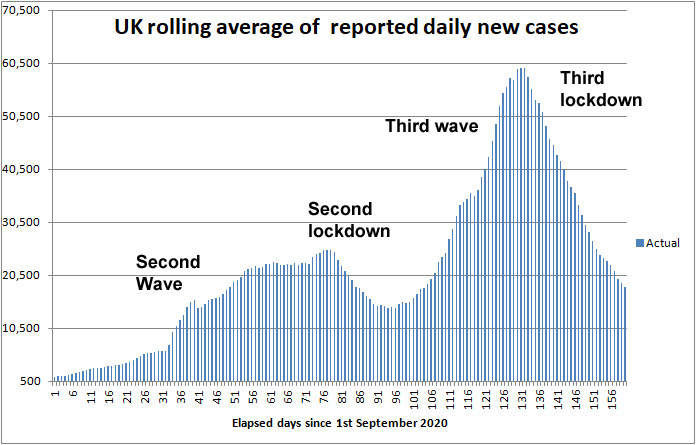
Angus and Rosemary's Miscellany
of Malvern - Other Resources
|
Coronavirus (COVID-19) epidemic weekly update for Malvern SeniorsCOVID LOCKDOWN in ENGLAND Alert Level raised to 5 on January 4th INFECTION RATE STILL HIGH PM says 'STAY AT HOME' Skip to menu of archived pages PreambleWe keep an eye on the published government figures to asses the level of risk in the Malvern Hills district, if there is an uptick in cases we will tell you. This page is updated every Sunday between 1800 and 2400 hours GMT. Information about Coronavirus can be found on the NHS website: https://www.nhs.uk/coronavirus
|
| Districts of Worcs | Cases | Weekly increase | Population |
| Bromsgrove | 5,665 | +180 | 98,529 |
| Malvern Hills | 2,349 | +107 | 77,545 |
| Redditch | 5,198 | +278 | 85,317 |
| Worcester | 5,397 | +270 | 103,542 |
| Wychavon | 5,595 | +282 | 126,240 |
| Wyre Forest | 4,733 | +186 | 100,957 |
| TOTAL | 28,937 | +1,303 | 592,130 |
| COMPARE WITH | |||
| County of Hereford | 6,163 | +207 | 195,000 |
| Leicester (city of) | 31,388 | +1,112 | 400,000 |
Cumulative cases reported by PHE in Worcestershire to 7th February 2021
Interactive map
At the bottom of the Coronavirus Dashboard (daily update) page there is an Interactive Map which is coloured to show the variation in infection rate across the country. The areas of highest infection are continuing to reduce.
Click for Interactive Map of COVID cases
Note: the Interactive Map works on desktop PCs but it's possible you may encounter difficulties using a tablet or smartphone.
The number of cases fell again this week. Recent weekly cases to 2nd February are: North Malvern 15; Malvern Link 21; Pickersleigh 9; Barnards Green 6; Malvern Wells and Priory 5; Callow End and Hanley 10; Upton and Welland 5. The picture changes daily.
Number of deaths
Statistics on COVID deaths are published by Public Health England, The Office of National Statistics, and NHS England.
PHE figures
Public Health England reports that the cumulative total of COVID (28) deaths in UK hospitals and care homes has risen by 6,307 in the last week to 112,464 while the daily average has fallen from 1,174 to 901; see chart below which show the actual daily death rate in red, and our forecast to 21st February in blue.
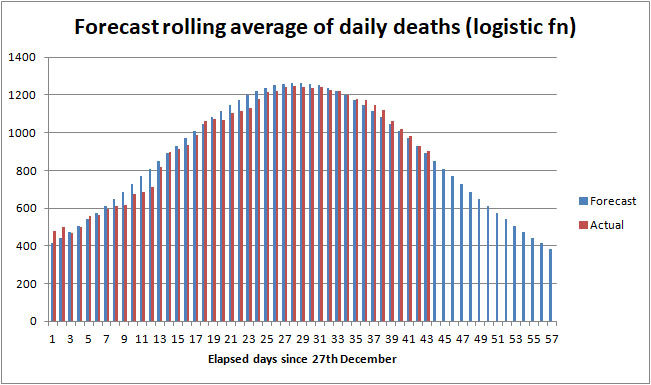
Actual daily UK death rate from 27th Dec to 7th February 2021 and forecast
You will see the third wave death rate has finally peaked and begun to fall.
Click to view the UK government Coronavirus Dashboard
In comparison averaged over recent years 1,700 people die daily from all causes.
In those districts where the COVID death rate is highest the storing of bodies in temporary mortuaries and delay to funeral services can be expected between now and the end of February.
ONS figures
The Office of National Statistics (ONS) separately reports registered deaths in England and Wales where COVID-19 is mentioned on the death certificate. The ONS figures lag the PHE figures by 10 - 14 days and do not include NI and Scotland, so are lower than the figures published by PHE.
The ONS figures are broken down by District providing a glimpse where deaths are occurring. The cumulative total of COVID related deaths in Worcestershire reported by the ONS up to 22nd January 2021 (week 3 of 2021) is shown below.
| Districts of Worcs | Deaths 2020 |
Deaths 2021 |
Weekly increase | Population |
| Bromsgrove | 164 | 40 | +17 | 98,529 |
| Malvern Hills | 61 | 38 | +13 | 77,545 |
| Redditch | 108 | 29 | +16 | 85,317 |
| Worcester | 87 | 59 | +21 | 103,542 |
| Wychavon | 157 | 45 | +26 | 126,240 |
| Wyre Forest | 171 | 35 | +15 | 100,957 |
| TOTAL | 748 | 246 | +105 | 592,130 |
Cumulative COVID deaths registered by ONS to 22nd January 2021
In the week ending 22nd January, there were 105 COVID related deaths in Worcestershire, of which 29 were in care homes, 6 at home, 2 at a hospice and 70 in hospital; the highest weekly total of the epidemic so far.
In total in England and Wales 8,850 COVID related deaths were reported by the ONS in the week to 22nd January, an increase of 1,149 (15%) on the week before.
The highest number of hospital deaths (>29) by Lower Tier Local Authority were:
Derby 30, Luton 30, Southend on Sea 43, Thurrock 32, Medway (Kent) 43, Milton Keynes 44, County Durham 41, Cheshire East 31, Cheshire West 35, Central Bedfordshire 31, Bournemouth Christchurch and Poole 51, Dorset 36, Buckinghamshire 68, Basildon 33, Colchester 32, Tendring 40, Liverpool 38, Sefton 45, Wirral 49, Sheffield 38, Birmingham 124, Sandwell 58, Walsall 39, Wolverhampton 47, Barking and Dagenham 35, Barnet 51, Bexley 45, Brent 51, Bromley 47, Croydon 56, Enfield 41, Greenwich 44, Hackney 32, Havering 44, Hillingdon 42, Hounslow 51, Lewisham 33, Merton 33, Newham 48, Redbridge 55, Southwark 32, Sutton 39, Tower Hamlets 41, Waltham Forest 38, Westminster 30, Betsi Cadwaladr University Health Board 47, Aneurin Bevan University Health Board 67, Cardiff and Vale University Health Board 41, Cwm Taf Morgannwg University Health Board 43, Swansea Bay University Health Board 39.
Once again Birmingham had the highest death rate.
The cumulative total of COVID related deaths in England and Wales recorded by the ONS for all weeks of the epidemic rose to 108,742.
| Year | Cumulative COVID related deaths in England and Wales |
| 2020 | 85,686 |
| 2021 | 23,056 |
| TOTAL | 108,742 |
COVID death toll in England and Wales to 22nd January 2021 (by ONS)
Click for national ONS data on deaths (Excel spreadsheet)
NHS England figures
More recently in the seven days ending 30th January NHS England reported the cumulative total of deaths in Worcestershire hospitals rose by 43 to 748.
Click for NHS COVID-19 Daily Deaths
Healthcare numbers
The UK government Coronavirus Dashboard includes important information about healthcare statistics.
| Hospital cases (UK) | Number | Weekly change |
| Patients currently in hospital | 29,326 | -5,457 |
| Patients on ventilation | 3,505 | -327 |
| Patients admitted daily | 2,332 | -707 |
Headline summary of patients in hospital as reported 7th February 2021
These headline figures show the number of COVID patients in hospital has fallen significantly.
The number of patients on ventilators is still greater than in the first wave which is bad news as the outcome for patients on ventilators is poor.
Daily admissions are now almost half the peak of the third wave which is encouraging. The steady state number of COVID patients in hospital seems to be roughly ten time the number of patients admitted daily, suggesting a fall to 23,000 patients is on the way. Possibly the NHS wants to get the number of COVID patients below 10,000 to free up beds for 'regular' patients; if so there is a way to go.
Figures for bed occupancy in Worcestershire hospitals can be found on the NHS England website:
Click for NHS England COVID-19 Hospital Activity
On 2nd February there were 221 COVID patients occupying beds in Worcestershire Acute Hospitals at Worcester, Kidderminster and Redditch (a fall of 13% on last week), and a further 64 in 'care' hospitals, a rise of 20 possibly due to COVID survivors being moved to rehabilitation beds. In England a total of 27,397 COVID beds were occupied a fall of 15% on last week.
Note: The Welsh First Minister said some time ago that very sick COVID patients arrive in hospital 7 to 10 days after first symptoms, and either die or are discharged 15 to 30 days after first symptoms in most cases. Hospital beds are occupied by suspected COVID patients, very sick COVID patients, and a few suffering from 'Long COVID' who may remain in hospital for much longer than 30 days.
Notes on projected figures
It appears hospitals are only admitting very sick COVID-19 patients, for example those with breathing difficulties, which is probably why Professor Peter Horby of Oxford University said on the Andrew Marr show that up to 20% of COVID patients in hospital could die.
The death rate compared to a percentage of daily hospital admissions, which had been a little higher than expected during late December and early January, seems to be reverting to the norm. The shape of the curve confirms the third wave daily death rate has peaked and should fall significantly during February.
Statistician Sir David Spiegelhalter of Cambridge University speaking separately on BBC TV said that, using his rule of thumb, hospital admissions were likely to be about 10% of reported new cases, one week after symptoms; and deaths were likely to be about 2% of new cases, 2 to 3 weeks after that - which would point to about 360 hospital deaths per day towards the end of February.
Forecast for the week ahead
Trends suggest that during the next seven days (up to 7th February) the cumulative total of new UK COVID-19 cases reported by PHE on the Coronavirus Dashboard could increase by about 110,000 towards 4,061,000.
In Worcestershire up to 1,200 new cases of COVID-19 can be expected, and possibly up to 100 cases in the Malvern Hills district.
We estimate the number of COVID (28) deaths could increase by about 5,000 nationally towards 118,000 during the 7 days ending 14th February 2021.
In the county of Worcestershire, assuming a 2.4% death rate, the 1,302 new cases this week could translate to about 30 Worcestershire deaths per week towards the end of February, but if cases are mostly confined to younger age groups it could be less.
Longer term forecast
Ending of the third wave of the COVID-19 epidemic in the UK
Daily new cases of Coronavirus have been falling steadily since the introduction of the third lockdown due to physical distancing. Once all the population has been vaccinated (currently September) the restrictions can be relaxed. Easing the restrictions too early say in March, as the government may intend, could lead to a fourth wave of sickness and more pressure on hospitals, but vaccination of those aged 60+ should prevent an excessive death rate.
Ideally the daily number of new cases needs to drop below 1,000 in order to give Test and Trace the chance to work and enable travel corridors to be opened with other countries. That equates to about 10 new cases per 100,000 per week.
For the time being the death toll will continue to mount until the vaccination programme eventually draws this COVID-19 epidemic to a close. We now expect the UK COVID death toll to reach 128,000 by the end of March 2021; see commentary.
Exactly what happens will depend on the public's compliance with the lockdown, the effectiveness of test and trace, any change in the lethality of emerging strains of the virus, future government policy, and most importantly the speed of the vaccine rollout.
Advice for Seniors
 The
daily number of new cases of Coronavirus is still unacceptably high,
and we judge the risk MODERATE to
HIGH for Seniors living in the
Malvern Hills district who have not been inoculated; see our annex and riskometer opposite.
The
daily number of new cases of Coronavirus is still unacceptably high,
and we judge the risk MODERATE to
HIGH for Seniors living in the
Malvern Hills district who have not been inoculated; see our annex and riskometer opposite.
The risk could be approaching LOW for Seniors who have been inoculated more than 3 weeks ago.
If you have not been inoculated and catch COVID there is a significant chance that you will either die or your long term health may be seriously damaged, so take care to protect yourself and those you love. 90% of COVID deaths are in those aged over 60 years according to NHS England statistics.
So if you are offered a jab grasp the opportunity with both hands.
The simple safeguards to remember are still to:
-
wash your HANDS thoroughly, using soap and hot water, for 20 seconds, including after handling deliveries to your home, to kill virus picked up from contaminated surfaces see note 1;
-
wear a FACE mask when unavoidably near other people for example when shopping, visiting hospital or the chemist;
-
SPACE at least 2 metres apart from others see note 2;
-
keep TIME near others as short as possible, see note 3;
-
self-isolate and book a test if you have COVID-19 symptoms (new continuous cough, fever or loss of, or change in, sense of smell or taste).
Hence the mantra:-
HANDS, FACE, SPACE, TIME - GET A TEST if you feel unwell.
Pulse Oximeter
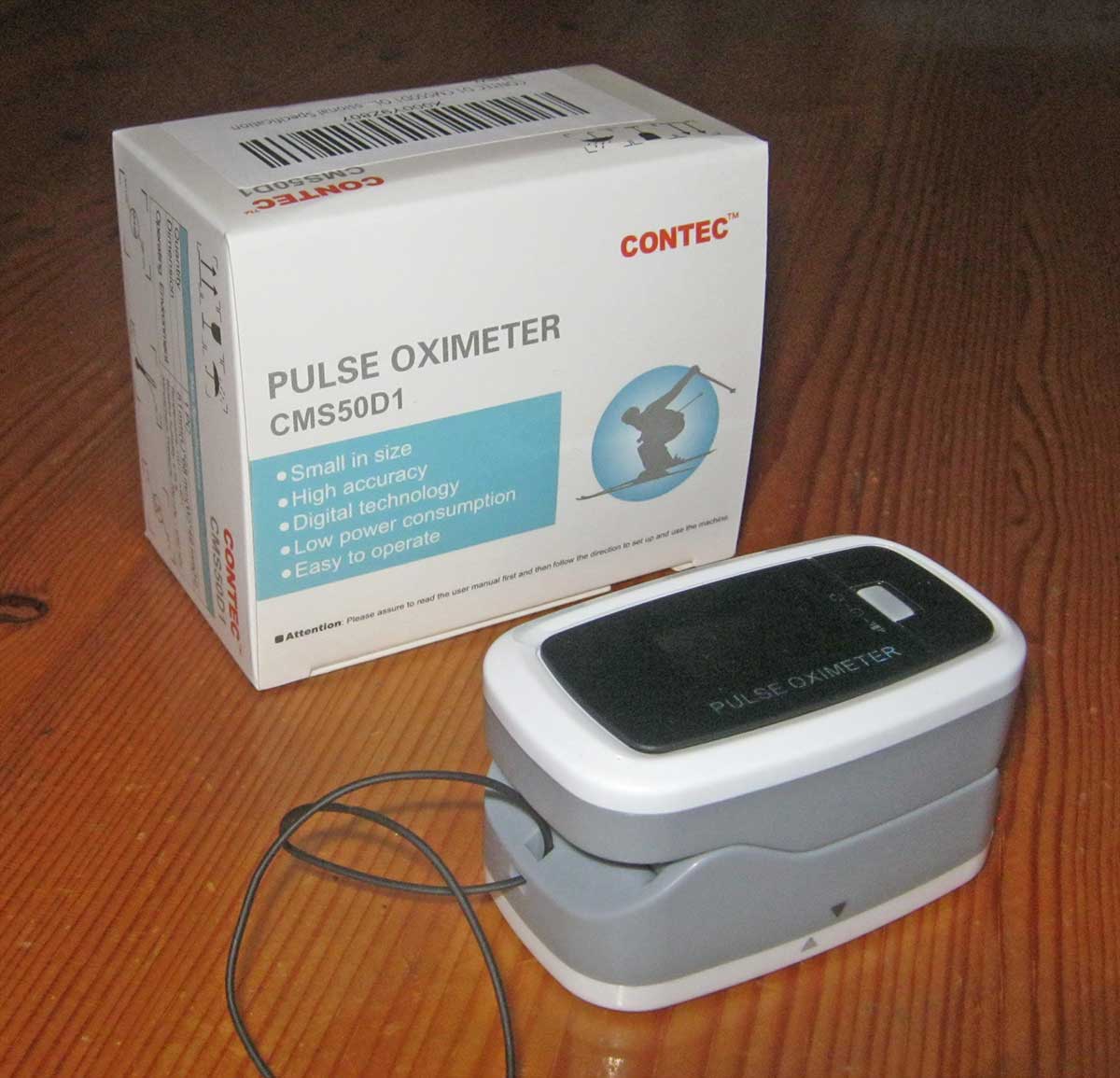 A
doctor in Bournemouth speaking on the evening news suggested
that if you were sick with COVID at home it would be a good idea to have a
little device known as a Pulse Oximeter handy (see photo on right). This
measures the oxygen saturation in the blood and pulse rate by clipping the
device on a finger and pressing a button; the reading should normally be at
least 97%.
A
doctor in Bournemouth speaking on the evening news suggested
that if you were sick with COVID at home it would be a good idea to have a
little device known as a Pulse Oximeter handy (see photo on right). This
measures the oxygen saturation in the blood and pulse rate by clipping the
device on a finger and pressing a button; the reading should normally be at
least 97%.
If the reading falls to about 93% you should call your doctor for advice, and if the reading is consistently below 92% you should consider calling an ambulance or visiting A&E.
Pulse Oximeters can be purchased from Amazon for £18 to £25; alternatively your doctor's surgery might loan you one if you are unwell and have tested COVID positive.
Remember, if you have symptoms of COVID-19 at home and can't count from one to ten out loud due to shortness of breath, you should immediately call your GP, 111 or 999 for advice.
Click for UK government Coronavirus guidance on what you can and cannot do
Notes:
1) Wash your hands thoroughly before touching your face to avoid transferring virus from contaminated surfaces to your mouth, eyes and nose. If outdoors use hand gel.
2) Two metres is further than you think - roughly an arm and a walking stick away.
3) During the National Lockdown you should not mix with other households.
Minimise exposure time if you unavoidably find yourself mixing in a confined setting - an invisible mist of virus can build up in the air if the space is shared with an infectious person; imagine people exhaling cigarette smoke. Unless you wear a well fitting FFP3 hospital grade face mask you can breath this in; a face covering will offer little protection. The likelihood and extent you get sick will depend on the density of the airborne virus, which can be reduced by ventilation, and the duration of your exposure.
Annex to 7th February update
Commentary
On Monday 1st February Matt Hancock gave a news briefing:-
He said 9,200,00 first jabs had been given of which 931,000 were over the weekend. 90% of those aged 80+ had been vaccinated and 50% of those in their 70s.
The UK was building a 'large scale' vaccine production capability which it had not had before. 400 million doses of COVID-19 vaccine were on order.
The Valneva vaccine would be manufactured at Livingstone in Scotland. 40 M extra doses had been ordered; delivery in 2022? The Novavax vaccine would be manufactured on Teeside.
He went on to say random tests had found 105 cases of the South African variant of COVID-19, mostly linked to travel, but 11 cases of community transmission had been found and it was important to find out how these had arisen.
The Astrazeneca vaccine was currently the only vaccine available to 'Rest of World' at cost price.
On Tuesday Test and Trace announced mass testing in certain postcodes in order to identify and isolate those infected with the South African variant of COVID-19.
Click for BBC report on urgent COVID testing
Nicola Sturgeon announced primary school children in Scotland would start going back to school on 22nd February.
Trials of the Oxford AstraZeneca vaccine confirmed the vaccine would reduce transmission and that delaying the second jab was acceptable.
Click for Astrazeneca press release
On Wednesday Boris Johnson gave the COVID news briefing.
He said 95% of those aged 75+ have had their first jab. Schools would start returning on 8th March and not before. A road map outlining the likely way forward would be produced by 22nd February.
Matt Hancock mentioned, in an interview, that the film Contagion (2011) had spurred him to make sure of a robust and reliable supply of vaccine and for a priority to be established early on to avoid squabbling.
On Thursday a trial was announced to determine the pros and cons of using a different vaccine for the second dose.
Sir Kier Starmer harangued the government for not forcing all travellers to quarantine in government designated centres.
On Friday it was announced primary schools in Wales would start returning on 22nd February. There was chatter in the media about the effectiveness or otherwise of quarantine hotels.
It was reported a case of the South African variant of the virus had been found in Fernhill Heath Worcester.
The government clarified that vaccination of 50-69 year olds by the spring meant by the end of May.
There was further discussion in the media proposing vaccine passports as a means of opening up foreign travel, suggesting overseas holidays for the 'jabbed' only.
The media reported a computer modelling study by Dr Sam Moore and others of Warwick University warning of the dangers of relaxing COVID restrictions too soon; it was suggested careful easing over 9 months might be necessary to prevent a fourth wave of the epidemic and keep the number of COVID patients in hospital below 10,000.
Click for article - When can the UK relax about COVID-19
In contrast some MPs and media headlines are expecting an early exit from controls, while mixed messages are coming from Matt Hancock who cautions against booking holidays abroad while looking forward to a great British Summer.
On Sunday vaccine minister Nadhim Zahawi speaking on the Andrew Marr show said the government had no plans to issue Vaccination Passports, but that did not rule out travellers obtaining a vaccination certificate from their doctor.
Professor Sarah Gilbert answered questions about the ability of the present Oxford vaccine to protect against the South African variant of COVID - possibly the vaccine is not so effective, but it is too early to say for sure. New versions of the Oxford vaccine are being developed to target the newly emerging variants of COVID which can rapidly go into production to provide for example an annual booster shot if needed.
Click for BBC Andrew Marr show
Vaccines
Matt Hancock says the speed of rollout of the vaccine is currently dependent on deliveries from Pfizer in Belgium and Astrazeneca in UK.
It is hoped to vaccinate the most vulnerable group (70+) by 15th February and the second group (50-69) by the end of May.
From mid March the vaccine will have to be diverted to giving second jabs; nevertheless there seems a good chance many of those aged 60+ will have had their first jabs by then.
Vaccination of those aged 50+ by the end of May will depend on either the delivery of the Moderna vaccine or deliveries of the Astrazeneca and Pfizer vaccines ramping up.
The timetable for vaccination of those aged 18-49 is more uncertain as four vaccines are yet to be approved. The government's target to do this by September appears realistic, but speculation in the media that this might be accomplished by June appears highly doubtful.
An informative article about the rollout of the COVID vaccine can be found on the BBC website.
| COVID-19 vaccine | Doses ordered (million) | Status |
| Pfizer BioNTech, two dose, -70 deg C | 40 | Approved, delivery has started, made in Belgium |
| Astrazeneca, two dose, fridge | 100 | Approved, delivery has started after some delay, made in UK |
| Moderna, two dose, -20 deg C | 7+10 | Approved, should be available in the 'spring', supplied from either Switzerland or Spain |
| Valneva, two dose | 60+40 | A jab from French company Valneva will be made in Livingston, West Lothian, Scotland. Delivery to start in second half of 2021. |
| Janssen, single dose | 30 | A jab from Belgian firm Janssen, owned by Johnson and Johnson; phase III trials complete, should be available later this year |
| Novavax | 60 | A jab manufactured by US firm Novavax will be made in Stockton-on-Tees; phase III trials complete, could be available later this year. |
| GSK Sanoft | 60 | Some delay due to adjusting the formula to give better protection to the elderly; possible availability late 2021. |
Table of vaccines ordered by the UK government
Recent deaths in Worcestershire hospitals
The table below shows all COVID deaths in Worcester hospitals reported by NHS England to 6th February.
| Worcestershire | Cumulative deaths | Weekly increase | |
| Acute hospitals | 697 | +42 | |
| Care hospitals | 51 | +1 | |
| TOTAL | 748 | +43 |
In the last week 43 additional deaths have been recorded compared to 50 the week before.
Present rate of new cases
This week, the average rate of infection per 100,000 population per week in England fell from 309 to 233. In comparison the figure for Worcestershire is 257 and that in the Malvern Hills 125.
As a guide we would expect the third lockdown to continue until the rate of infection rate falls to somewhere between 10 and 50 cases per 100,000 per week, so there is still some way to go.
In the meantime Seniors awaiting vaccination need to continue to be careful.
The probability of catching Coronavirus in the Malvern Hills is moderate, but combined with the significant risk of death makes us view the overall risk to Seniors, prior to inoculation, as MODERATE to HIGH.
The risk of death from Coronavirus for healthy teenagers is exceedingly small so for them the risk is LOW, whereas the middle aged can suffer from Long COVID so for them the risk might be assessed MODERATE.
Forecast of death rate during February and March
The average UK COVID daily death rate peaked at 1,200 deaths per day about 25th January and has begun to fall principally due to physical distancing. In coming weeks the vaccination programme should lead to a steady fall in the death rate with deaths possibly tailing off to about 100 deaths per day during March. We predict the rolling 7 day average death rate will roughly fall from 900 to 600 by 14th February, then to 400 by 21st, possibly dropping towards 220 deaths per day by the end of the month, possibly leading to about 11,000 additional deaths.
Then assuming the death rate falls further to 100 deaths per day by the end of March as a result of the vaccination of over 60 year olds, the average could be 160 deaths per day in March leading to about 5,000 additional deaths.
Adding these 'back of the envelope' numbers suggests the UK COVID-19 death toll could reach 128,465 by the end of March.
| Date | Forecast UK COVID-19 death toll |
| February 7th | 112,465 |
| February 28th | +11,000 |
| March 31st | +5,000 |
| Total | 128,465 |
Forecast UK COVID-19 epidemic death toll by end March 2021
Another projection of the future COVID-19 death toll and daily deaths can be found on The Institute for Health Metrics and Evaluation website:
Click for IHME projection of COVID-19 deaths
The latest projection is for 156,000 deaths by the end of March which seems a little high to us.
At the start of the epidemic in March the Chief Scientific Adviser, Sir Patrick Valance, suggested a death toll of 20,000 would be a good outcome; on the other hand, Professor Neil Ferguson of Imperial College warned in some scenarios the death toll might be as high as 250,000; while we thought, in the very worst case assuming up to 1% of the UK population died the outcome might have been nearer 400,000 taking into account some build up of herd immunity.
So how well will the UK have done? When Sir Patrick Valance spoke off the top of his head there had been few deaths and he clearly did not want to 'scare the horses'. Professor Neil Ferguson was nearest the mark. A few might consider an outcome of 128,000 deaths a fair result compared to a greater number of people dying in a very short space of time, more being permanently disabled by Long COVID, and temporary collapse of the NHS. Members of the Labour Party and others will no doubt say the UK has done very poorly compared to the best performing countries such as Australia, New Zealand and Singapore where deaths have been much lower, not to mention the enormous expense of supporting those out of work and huge damage to the economy.
Ultimately there can be no winners or losers, but there must eventually be a thorough inquiry to learn lessons for the future.
Summary of Links
Symptoms
Article about the effects of Coronavirus on the human body
Reporting and how to obtain a test
How to get a test
https://www.nhs.uk/coronavirus
About joining the Zoe COVID Symptom Study:
Guidance
UK government Coronavirus guidance
Tiers
Guidance on tiers: what you need to know
Government postcode checker to find tier for other areas
Statistics
UK government Coronavirus Dashboard
Coronavirus Dashboard Interactive Map
ONS data on deaths in England and Wales (Excel spreadsheet)
NHS England COVID-19 Daily Deaths
NHS England COVID-19 Hospital Admissions
NHS England vaccination statistics
Reports
ONS Coronavirus (COVID-19) Roundup
The bigger picture
Worldometer summary of coronavirus cases worldwide
European Centre for Disease Prevention and Control info
https://www.ecdc.europa.eu/en/geographical-distribution-2019-ncov-cases
World Health Organisation info
Window on the USA
Centre for Disease Control (CDC)
American Association of Retired People (AARP)
Worcestershire
Help:
http://www.worcestershire.gov.uk/here2help
Worcestershire County Council COVID-19 information:
http://www.worcestershire.gov.uk/coronavirus
Here you will find a useful link,
'Website: Number of new cases by date in Worcestershire'
which displays interesting COVID charts and statistics for Worcestershire
Miscellaneous
Spanish Flu
Dr Jeff Kildea's commentary about the 1919 outbreak of Spanish Flu in Australia
Views of Martin McKee, Professor of European Public Health
Follow Martin McKee on Twitter
SAGE membership
Scientific Advisory Group for Emergencies (SAGE)
Scottish government:
Link to Scottish Government website
Link to Postcode checker for COVID restrictions by protection level in areas of Scotland
Welsh Government:
Guidance on COVID alert levels in Wales

The interpretations and opinions expressed are our own
Last updated 7th February 2021
 Blogs
>
Blogs
>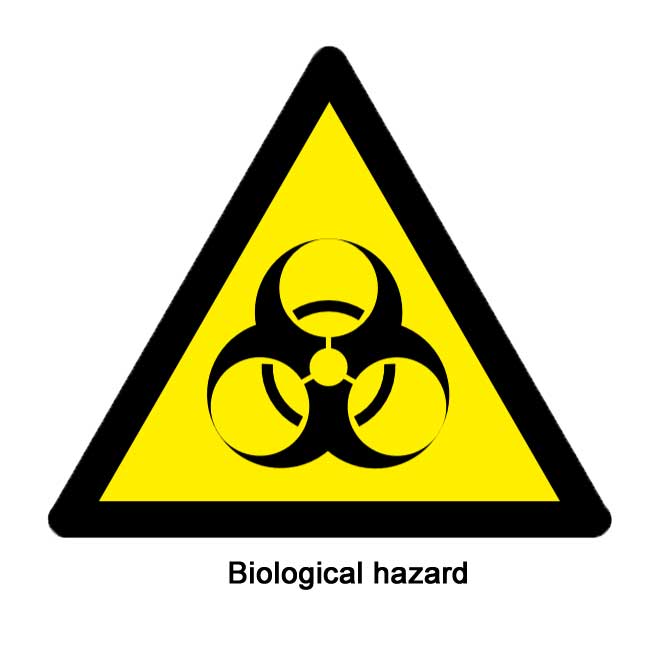 How
to request a test
How
to request a test Please
consider helping others by downloading the COVID Symptom Study app onto your
smart phone or Ipad and reporting how you feel either daily, or as you are
able. Note that currently there is no desktop PC version.
Please
consider helping others by downloading the COVID Symptom Study app onto your
smart phone or Ipad and reporting how you feel either daily, or as you are
able. Note that currently there is no desktop PC version.